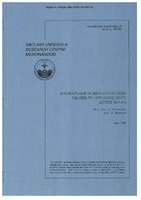| dc.contributor.author | Max, Michael D. | |
| dc.contributor.author | Portunato, Nicola | |
| dc.contributor.author | Murdoch, G. | |
| dc.date.accessioned | 2018-10-11T14:07:51Z | |
| dc.date.available | 2018-10-11T14:07:51Z | |
| dc.date.issued | 1996/06 | |
| dc.identifier | 10651 | |
| dc.identifier.govdoc | SM-306 | |
| dc.identifier.uri | http://hdl.handle.net/20.500.12489/366 | |
| dc.description.abstract | Low Frequency Active Sonar (LFAS) utilizes low-frequency acoustic | |
| dc.description.abstract | emissions to detect submarines. Where strong retlections occur on the seabottom which produce environmental scatter (reverberation), response from the submarine target may be masked or false contacts may be reported. Constructing predictive maps of anticipated sonar response zones in order to identify the background clutter is one of the main goals in the preparation of environmental data sets for areas in which LFAS may be employed operationally. It has been demonstrated that reflectors buried in the seafloor can cause substantial reflections that will be mapped geographically incorrectly where the incident acoustic ray-paths pass back from the buried reflector toward the receiving array through the seafloor. Thus, it is necessary to characterize fully both the seatloor crricl the subseafloor acoustic response of shallow water areas in which LFAS ASW operations | |
| dc.description.abstract | may be carried out. | |
| dc.format | vi, 19 p. : ill. ; 11 fig. | |
| dc.language | English | |
| dc.publisher | NATO. SACLANTCEN | |
| dc.relation.ispartofseries | ADA378113 | |
| dc.subject | Submarine detection | |
| dc.subject | Low Frequency Active Sonar (LFAS) | |
| dc.subject | Acoustic reverberation | |
| dc.subject | Seafloor | |
| dc.subject | Acoustic reflection | |
| dc.title | Sub-sea floor buried reflectors imaged by low frequency active sonar | |
| dc.type | Scientific Memorandum (SM) | |
